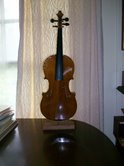Email Michaele: ([email protected]]
Mystery with Strings
A Short Story by Michaele Benedict

Musical instruments have their own lives. Most of them outlast one generation, so they get passed down, passed along, get lost and found again, get put away in attics, get stolen, recovered, or offered at junk sales like the little violin which finally regained its voice recently in Montara.
It was a rather battered orange-painted instrument missing some essential parts, so it was impossible to know what it might sound like. A friend whose daughter plays violin had found and bought it, thinking it would be a shame for an instrument, even a battered instrument, to wind up among garage sale cast-offs.
Burned into the back of the violin were the words “Philadelphia, Pennsylvania, School District.” “I telephoned them,” the rescuer said, “and asked if they wanted it back, but they said they hadn’t had a string program for years, so they had no use for the violin.”
My cellist husband, who sometimes makes minor repairs on stringed instruments, heard about the discarded violin and asked if he could look it over for a while. Chipped varnish covered the maple and ebony. There were various scars and dings. But visible through the F-holes (the scrolled openings on the tops of stringed instruments) was a label which said “Antonio Curatoli, Mittenwald, Germany, 1928” and “Copy of Amati”.
“This might be a pretty good German violin,” Charles speculated.
I was curious about Antonio Curatoli and tried to research the mysterious luthier or instrument maker. The consensus among fiddle fanatics seemed to be that there may or may not have been an actual maker named Antonio Curatoli. He may have been a Neopolitan seller of violin strings who learned to make instruments. Or the name may more likely have been a trade name of the German violin company E. R. Schmidt, whose instruments were imported in the early 20th century by various companies including Sears. “Sort of like Betty Crocker,” Charles said.
The Curatoli violins sold for about 25 dollars in the 1920s, but they are bringing two or three thousand in these days of scarce fine wood and carbon fiber substitutes. The Philadelphia violin was, of course, virtually worthless as it was.
For several months, the violin sat in various places in our house, being scraped, sanded, and finally varnished with amber, a bit at a time. It perched, drying, on a kind of stand, where it was frequently examined (longingly, I thought) by the teenager whose father had found it.
This young woman applied for and received a scholarship from the Coastside Community Orchestra with the hope of having the violin finished off by Charles’ luthier friend who made his lovely cello. The varnished violin, missing tailpiece, bridge and strings, went to San Francisco.
The maker reshaped the fingerboard, replaced a missing peg and rebushed the other three, made a bridge and recalculated its placement according to the original specs. He put on strings and wrote up the bill for a third what the work was worth.
Yesterday, the luthier returned the Curatoli in working condition, and as fate would have it (I love to say “as fate would have it”) the young violinist happened to be at the house at the time, taking a piano lesson. The luthier handed over the violin. Four of us waited breathlessly to see what the violin would sound like.
First things first: She tuned it, she borrowed a bow, and she tucked it under her chin. Then she played the beginning of a Bach violin concerto. It was beautiful.
=============
Michaele Benedict lives in the “artist community” of Montara. Her latest book is called “Searching for Anna.”
